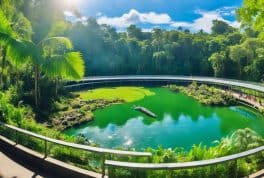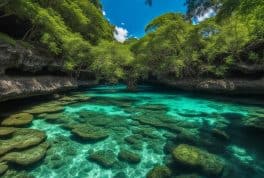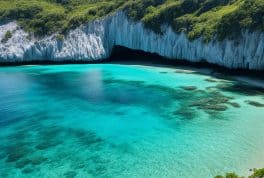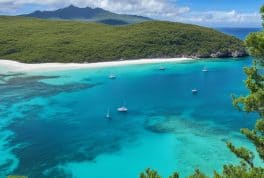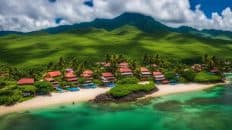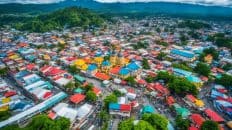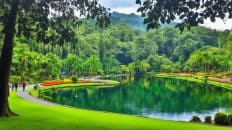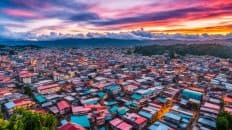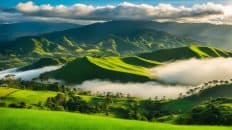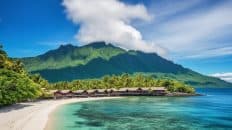Mindanao Island
Mindanao, a jewel of the Philippines, is renowned for its diverse cultures, stunning natural landscapes, and rich history. This vibrant island boasts lush forests, the majestic Mount Apo, and serene beaches, alongside a tapestry of indigenous and Muslim heritage. Despite challenges, Mindanao's resilient spirit and natural beauty make it a captivating and unique destination.
Top 10 Questions and Answers about Mindanao
What is Mindanao known for?
Mindanao, the second-largest island in the Philippines, is known for its rich cultural diversity, natural resources, and vibrant festivals. It’s home to various ethnic groups, including the Lumad and Moro people, and features diverse landscapes from mountains like Mount Apo to beautiful beaches and agricultural lands.
What are the main languages spoken in Mindanao?
The main languages spoken in Mindanao include Cebuano, Chavacano, Tausug, Maguindanao, Maranao, and Surigaonon. Filipino and English are also widely spoken and understood.
What is the significance of Davao City in Mindanao?
Davao City, one of the largest cities in Mindanao, serves as a commercial, cultural, and industrial hub for the island. It’s known for its durian production, multicultural community, and as a gateway to Mindanao’s attractions.
What are the major industries in Mindanao?
Major industries in Mindanao include agriculture (particularly fruit cultivation like bananas and pineapples), fishing, mining, and forestry. The island is also developing its tourism, manufacturing, and technology sectors.
What is the climate like in Mindanao?
Mindanao has a tropical rainforest climate, characterized by relatively high temperatures and humidity, and significant rainfall throughout the year. It’s less prone to typhoons compared to other parts of the Philippines.
Are there any security concerns for travelers in Mindanao?
What are some popular tourist attractions in Mindanao?
Popular attractions include Siargao Island for surfing, Samal Island for beaches, Mount Apo for trekking, the Enchanted River in Surigao, and the cultural heritage sites in Marawi and Zamboanga City.
What is the historical background of Mindanao?
Mindanao has a rich history influenced by various cultures and foreign powers. It was a center of Islamic influence in the Philippines, with Sultanates established before Spanish colonization. The region has a complex history of resistance against colonialism and a continuing quest for peace and autonomy.
How does Mindanao contribute to the Philippines’ economy?
Mindanao is a significant contributor to the Philippine economy, especially in terms of agricultural output, including major exports like bananas and pineapples. It also contributes to the country’s fishing, mining, and tourism sectors.
What are the cultural festivals in Mindanao?
Mindanao hosts vibrant cultural festivals, such as Kadayawan in Davao, celebrating the island’s harvests and indigenous cultures, and the Zamboanga Hermosa Festival, reflecting the region’s Spanish-influenced heritage.
Guides and Tours
Cities on Mindanao
- Davao City
- Zamboanga City
- Cagayan de Oro
- General Santos
- Iligan
- Butuan
- Pagadian
- Valencia
- Marawi
- Tagum
- Malaybalay
- Digos
- Cotabato City
- Oroquieta
- Surigao City
- Tandag
- Mati
- Dipolog
- Bayugan
- Isabela City
- Kidapawan
- Bislig
- El Salvador
- Panabo
- Samal
- Tacurong
- Gingoog
- Koronadal
- Cabadbaran
- Ozamiz
- Tangub
- Lamitan
Provinces of Mindanao
- Agusan del Norte
- Agusan del Sur
- Basilan (excluding Isabela City)
- Bukidnon
- Camiguin
- Compostela Valley (now known as Davao de Oro)
- Cotabato (North Cotabato)
- Davao del Norte
- Davao del Sur
- Davao Oriental
- Davao Occidental
- Lanao del Norte
- Lanao del Sur
- Maguindanao
- Misamis Occidental
- Misamis Oriental
- Sarangani
- South Cotabato
- Sultan Kudarat
- Sulu
- Surigao del Norte
- Surigao del Sur
- Tawi-Tawi
- Zamboanga del Norte
- Zamboanga del Sur
- Zamboanga Sibugay

Top 10 Things to see in Mindanao
- Mount Apo - The Philippines' highest peak, offering breathtaking views and challenging treks.
- Siargao Island - Known as the surfing capital of the Philippines, with stunning beaches and surf spots.
- Samal Island - Famous for its clear waters, white sand beaches, and resorts.
- Lake Sebu - A serene natural lake, known for its traditional T'boli culture and scenic landscapes.
- Enchanted River - A mysterious and beautiful river in Hinatuan, known for its clear, deep blue water.
- Camiguin Island - An island known for its volcanoes, hot springs, and waterfalls.
- Tinuy-an Falls - A breathtaking multi-tiered waterfall often referred to as the "Niagara Falls of the Philippines."
- Tawi-Tawi's Bud Bongao - A sacred mountain offering panoramic views, rich biodiversity, and cultural significance.
- Zamboanga City - Known for its unique blend of Spanish and Moro cultures, vibrant vintas, and Fort Pilar.
- Aliwagwag Falls - A stunning series of more than 100 cascading waterfalls in Davao Oriental, set in a lush forest reserve.
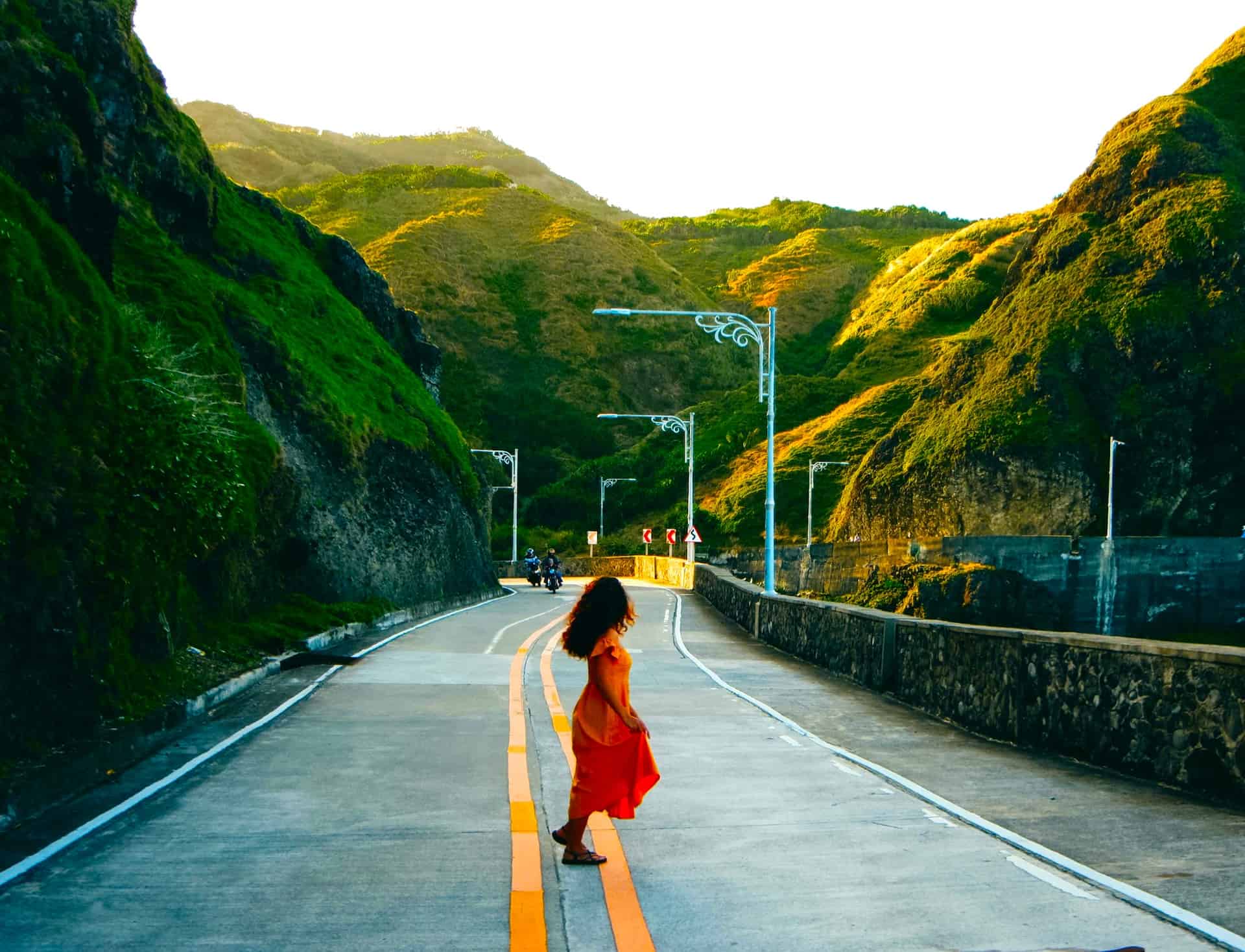
Why you should Visit Mindanao
Discovering Mindanao: A Journey to the Heart of Diversity and Beauty
The Land of Unparalleled Beauty
Mindanao, often hailed as the Philippines' hidden gem, offers a breathtaking landscape that combines pristine beaches, majestic mountains, and lush forests. The island's natural beauty, from the peak of Mount Apo to the serene waters of Siargao, provides a haven for nature lovers and adventure seekers alike. Visiting Mindanao promises an immersive experience in some of the most stunning and diverse environments in Southeast Asia.
A Melting Pot of Cultures
Mindanao is a cultural mosaic. The island is a vibrant tapestry woven from the traditions of its various ethnic groups, including the Lumad and Moro peoples. Each community in Mindanao contributes to a rich cultural heritage seen in colorful festivals, traditional dances, and exquisite crafts. A visit to Mindanao is not just a journey through places but also a deep dive into a rich, cultural narrative.
Culinary Delights
The cuisine in Mindanao is as diverse as its culture. The island offers a plethora of flavors, from the freshest seafood dishes to the exotic tastes of local fruits like durian. Each region in Mindanao adds its unique twist to Filipino cuisine, making it a must-visit destination for food enthusiasts.
Adventure Awaits
Mindanao is an adventure-seeker’s paradise. Whether it's surfing the waves of Siargao, trekking to the summit of Mount Apo, or exploring the depths of the Enchanted River, Mindanao offers a wide array of activities for every type of adventurer. The island’s diverse geography provides countless opportunities for experiences that range from thrilling to serene.
The Warmth of the People
A visit to Mindanao is made memorable by the warmth and hospitality of its people. The locals are known for their friendly demeanor and are eager to share their culture and stories with visitors. The sense of community and belonging in Mindanao is palpable, making every visitor feel welcomed and appreciated.
Sustainable Tourism
Mindanao is increasingly focusing on sustainable tourism practices. By visiting Mindanao, tourists contribute to local economies and encourage the preservation of the island's natural and cultural heritage. The growing awareness around sustainable tourism in Mindanao ensures that the beauty and integrity of the island are maintained for future generations.
A Destination for All
Whether traveling solo, with family, or as part of a group, Mindanao has something for everyone. The island's diverse offerings cater to different preferences and interests, making it a versatile destination. From tranquil beaches to vibrant cultural experiences, Mindanao provides a comprehensive and fulfilling travel experience.
In conclusion, Mindanao is a destination that should be on every traveler's list. Its natural beauty, rich culture, delicious cuisine, and the warmth of its people make Mindanao a unique and unforgettable destination. A trip to Mindanao is more than just a vacation; it's an exploration of diversity, an adventure of a lifetime, and an opportunity to connect with a rich cultural heritage.
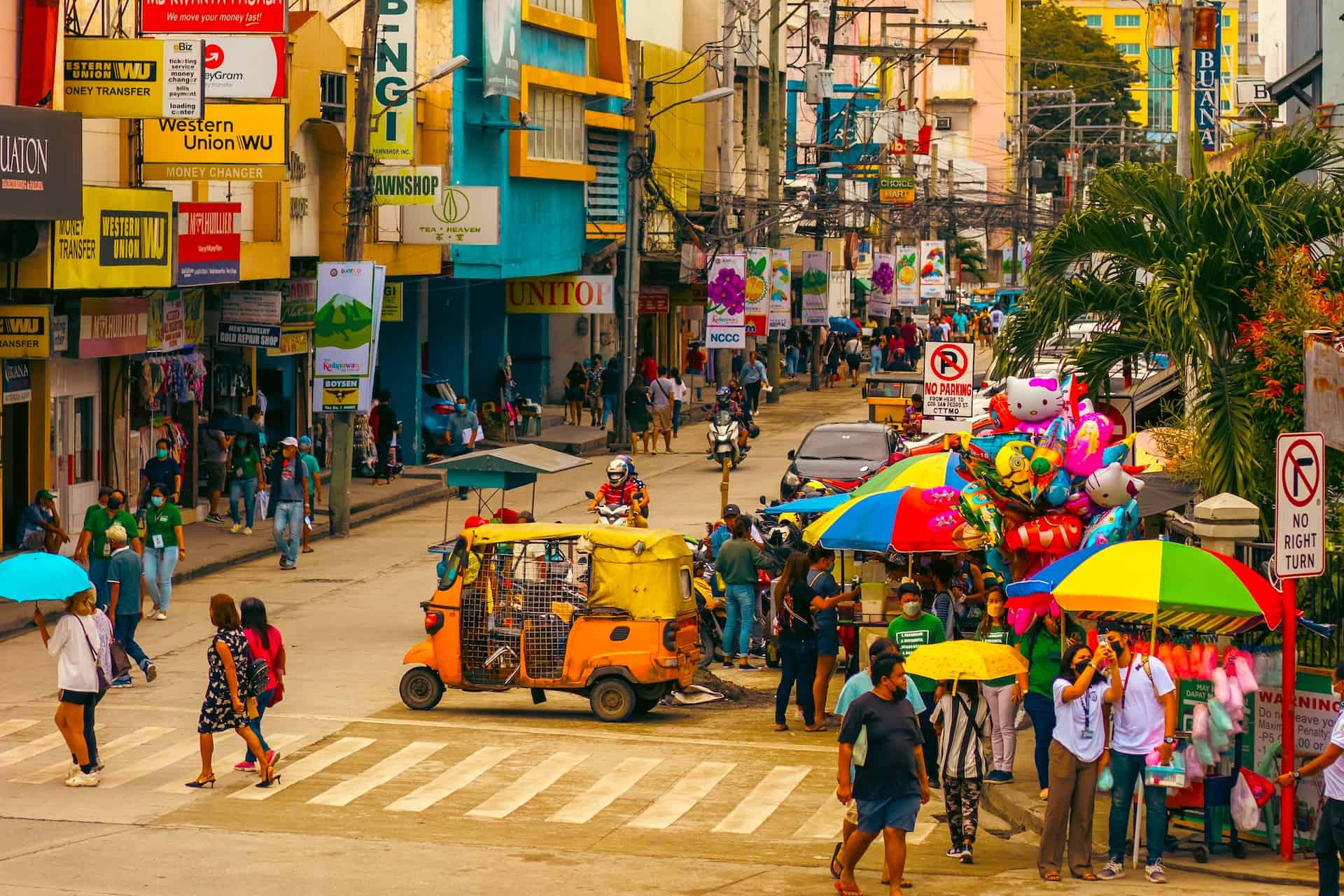
Mindanao Facts
1. Introduction to Mindanao: The Land of Promise and Diversity
Nestled in the southern part of the Philippine archipelago lies Mindanao, an island that resonates with a rich tapestry of cultures, breathtaking landscapes, and a storied past. Often referred to as the "Land of Promise," Mindanao stands as a testament to the Philippines' diverse heritage and potential. Spanning over a vast area, the island group encompasses not only the main island but also several surrounding islands, each with its own unique charm and significance. This section delves into the multifaceted aspects of Mindanao, laying the foundation for understanding this remarkable region of the Philippines.
Mindanao, as the second-largest island in the Philippines, is a land of contrasts and complexities. It boasts a landscape that ranges from rugged mountains to fertile valleys, interspersed with rivers and lakes. The island group includes Mindanao Island itself and smaller islands like the Sulu Archipelago. These outlying islands add to the geographical diversity of the region, making Mindanao a microcosm of the Philippines' natural beauty.
The island's name, "Mindanao," is derived from the Maguindanaon word 'mina,' meaning 'mine,' and 'dano,' signifying 'land.' This etymology hints at the rich natural resources that the island possesses. Mindanao's soil is fertile, its forests lush, and its mineral deposits abundant, making it a land ripe with promise for agricultural and economic development. The name "Mindanao" has come to symbolize not just a geographical location, but a region rich in resources and potential.
Mindanao's history is as colorful as its landscapes. The island has been a melting pot of various cultures and influences. The influence of Islam, which reached Mindanao through traders and missionaries from neighboring regions, has been particularly significant, especially in the southwestern part of the island. This has led to a distinct cultural identity for Muslim Mindanao, contributing to the rich tapestry of the island's heritage.
Mindanao's population is a vibrant mosaic of ethnic groups and cultures. This diversity is reflected in the many languages spoken across the island, with Cebuano, Hiligaynon, and Chavacano being some of the widely spoken tongues. Mindanao's ethnic diversity is not just a demographic feature but a cornerstone of the island's identity. Each group brings its own traditions, beliefs, and practices, contributing to the rich cultural landscape of Mindanao.
The island is administratively divided into several regions, each with its distinct character. Northern Mindanao, for example, is a province known for its agricultural lands and bustling cities like Cagayan de Oro. The Davao Region, on the other hand, is home to Davao City, one of the largest cities in the Philippines by land area. Davao City is often regarded as the de facto capital of Mindanao, given its economic and cultural significance. The Zamboanga Peninsula, another key region located on mainland mindanao, is known for its vibrant culture and historic Zamboanga City. Each of these regions contributes uniquely to the overall tapestry of Mindanao.
The Mindanao Island Group is not just about mainland areas; it also includes the Sulu Archipelago, a chain of islands located in the north and southwestern part of the Philippines. This archipelago is an integral part of Mindanao's geographic map and cultural identity. The islands located here have their own unique history and cultural heritage, adding layers to the already diverse narrative map of Mindanao.
Economically, Mindanao plays a crucial role in the Philippines. Its vast majority of agricultural lands contribute significantly to the country's food supply. Mindanao is a major producer of fruits like durian and bananas, and its seas are teeming with marine life, making it a key player in the fishing industry. The economic landscape of Mindanao is not limited to agriculture and fishing; the island also has a growing services sector, especially in major cities like Davao City and Cagayan de Oro.
Mindanao's development, however, has been uneven. While some areas have seen rapid growth and modernization, others remain mired in challenges. Conflict-affected areas, particularly in the Muslim-dominated regions, have faced issues of peace and security. Efforts by the national government and local stakeholders have been ongoing to address these challenges and foster sustainable development throughout Mindanao.
The Philippine Statistics Authority and the National Statistics Office play a crucial role in understanding Mindanao's dynamics. Through their data collection and analysis, they provide insights into the population trends, economic developments, and social changes occurring across the island. This information is vital for policymakers, development workers, and the general population to make informed decisions about Mindanao's future.
Mindanao's total population, is not just a statistic; it represents a diverse community of people with their hopes, dreams, and aspirations. From the bustling streets of Davao City to the quiet villages in the mountains, the entire population of Mindanao contributes to the island's vibrancy and resilience. The people of Mindanao, with their diverse backgrounds and experiences, are the true heart of the island.
In conclusion, Mindanao is more than just an island in the southern Philippines; it is a region of immense potential and diversity. From its mountain ranges to its urban centers, Mindanao encapsulates the complexities and beauty of the Philippine archipelago. As we delve deeper into the various aspects of Mindanao in the following sections, we will explore the intricacies of its geography, culture, history, and people. Mindanao is not just a land of promise; it is a land of diversity, resilience, and endless possibilities.
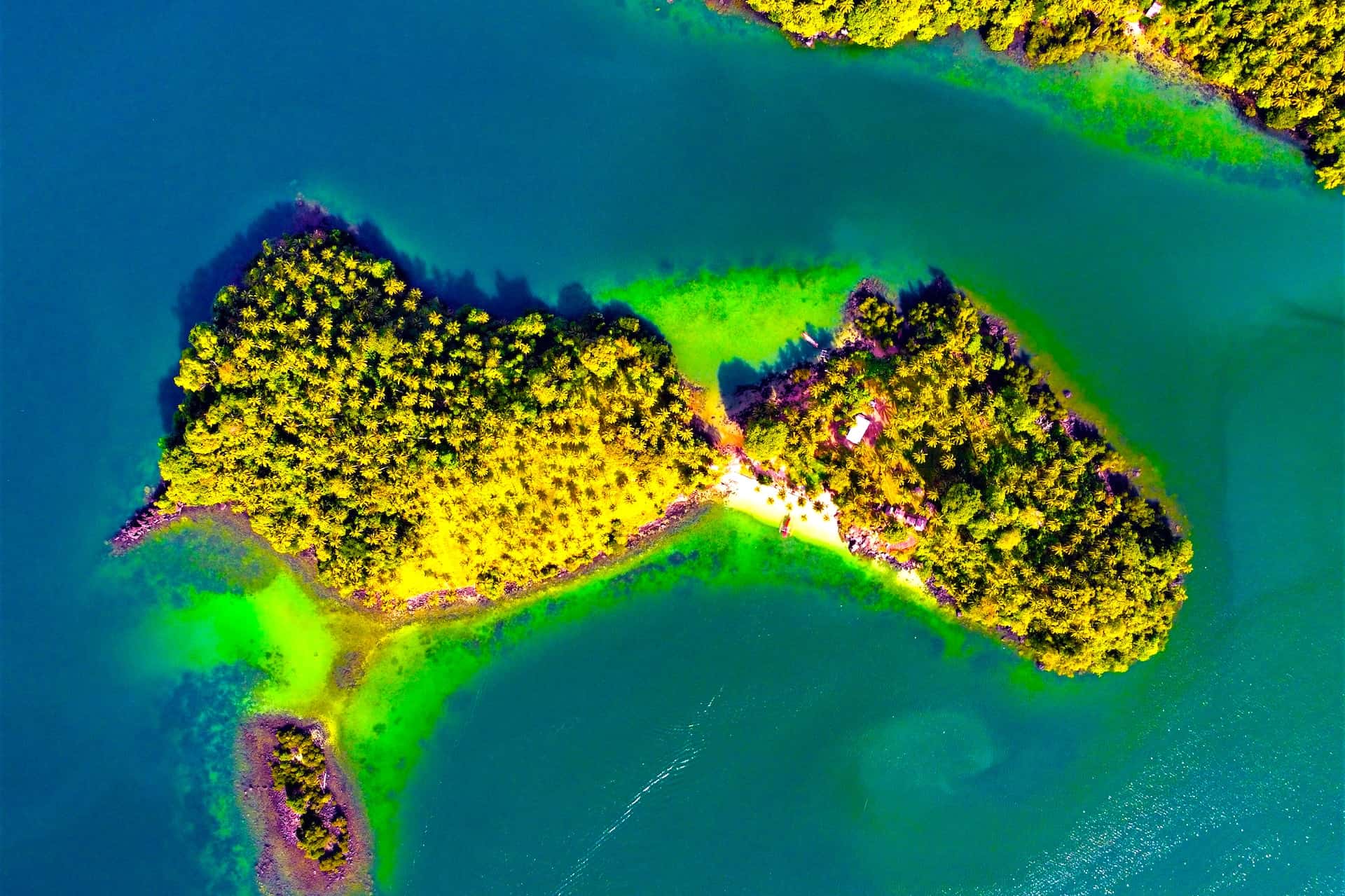
2. Geographical Overview of Mindanao: A Tapestry of Landscapes and Regions
Mindanao, the second-largest island in the Philippines, offers a geographical tapestry that is as varied as it is vast. From the northern reaches to the southern shores, Mindanao's landscapes encompass rugged mountains, serene beaches, lush forests, and vibrant cities. This section provides a comprehensive overview of Mindanao's geography, focusing on its major regions, including Northern Mindanao, the Davao Region, the Zamboanga Peninsula, and the south and southwestern areas of the island.
Northern Mindanao: A Blend of Nature and Urbanization
Northern Mindanao, a region characterized by its diverse landscapes and economic potential, is a significant part of the Mindanao Island Group. The region is home to major cities such as Cagayan de Oro, known for its white-water rafting and vibrant economy. The province of Bukidnon, with its vast pineapple plantations, complements the urban energy of Cagayan de Oro with its rural charm. Northern Mindanao exemplifies the balance between urban development and natural beauty, making it a microcosm of the island's overall diversity.
The region's geography varies from coastal areas to inland mountains, providing a home for a wide range of flora and fauna. The Mindanao island's rich biodiversity is especially evident in Northern Mindanao, where protected areas and parks preserve its unique ecological heritage. This region, part of the larger Mindanao Island Group, plays a crucial role in the environmental conservation efforts of the Philippines.
The Davao Region: The Heart of Mindanao's Economy
The Davao Region, another pivotal area in Mindanao province, the same province whose same name, is often synonymous with Davao City municipality. As one of the largest cities in the Philippines, both in terms of land area and population, Davao City municipality is a hub of commerce, culture, and governance in Mindanao. The city municipality's importance to the Mindanao region cannot be overstated; it serves as the de facto capital of the island, driving much of its economic growth.
The Davao Region extends beyond Davao City, encompassing provinces like Davao del Sur province, Davao del Norte, and Davao Oriental provinces. These provinces contribute to the region's agricultural output, which includes Mindanao's famed durian and other tropical fruits. The Davao Region's agricultural prowess, combined with its urban centers, makes it a cornerstone of Mindanao's economy.
Zamboanga Peninsula: Cultural Crossroads of Mindanao
The Zamboanga Peninsula, jutting out to the west of Mindanao, is a region rich in cultural heritage. Zamboanga City, the region's center, is known as "Asia's Latin City" due to its unique Chavacano language, a Spanish-based creole. The city's history, reflected in its architecture and traditions, adds a distinct flavor to the Mindanao Island Group's cultural landscape.
The peninsula's geography includes coastal areas and inland mountains, contributing to its diverse ecosystems. Mindanao's overall ecological diversity is reflected in the Zamboanga Peninsula's coral reefs, mangrove forests, and mountain ranges. This region plays a vital role in the environmental mosaic of Mindanao, with its unique geographical features and rich biodiversity.
Southwestern Mindanao: A Region Shaped by History and Nature
Southwestern Mindanao, encompassing areas like the Sulu Archipelago and parts located north and south of the Zamboanga Peninsula province, is an area deeply rooted in history and natural beauty. The Sulu Archipelago, part of the Mindanao Island Group, is known for its pristine beaches and rich marine life. The archipelago's islands are a testament to Mindanao's geographical diversity north, offering a contrast to the mainland's mountainous terrain north.
This region of Mindanao is also significant for its historical and cultural heritage. The influence of Islam in the Philippines is most evident in Southwestern Mindanao, where the culture and traditions of Muslim Mindanao are prominently displayed. The region's history is intertwined with the broader narrative of the Mindanao Island Group, showcasing the island's role as a cultural crossroads in the Philippines.
Mindanao's Geographic Significance
The geographical overview map of Mindanao reveals an island group that is not only diverse in its landscapes but also in its cultural and economic contributions to the Philippines. The regions, municipalities and provinces located out of Northern Mindanao, the Davao Region, the Zamboanga Peninsula province, and Southwestern Mindanao each bring their unique characteristics to the tapestry map of Mindanao.
Mindanao's geography has played a pivotal role in shaping the island's history and development. The mountainous areas, including Mindanao's highest peak, Mount Apo, have been crucial for ecological balance and cultural significance. The coastal regions and outlying islands like the Sulu Archipelago have contributed to the maritime culture and economy of Mindanao.
The urban centers of Mindanao, particularly cities like Davao City, Cagayan de Oro, and Zamboanga City, are not just economic hubs but also melting pots of culture and innovation. These cities reflect the entire population's aspirations and challenges in Mindanao, serving as focal points for development and progress.
Mindanao's vast majority of rural areas complement its few population and urban centers. The agricultural lands spread across the island group provide sustenance and livelihood for a significant portion of Mindanao's population. The balance between urban development and rural life is a key aspect of Mindanao's geographic and demographic landscape.
The Mindanao Island Group, in its entirety, represents the Philippines' diversity and potential. Its varied geography, encompassing mountains, islands, cities, and rural areas, forms the backdrop against which the story of Mindanao unfolds. This geographical diversity is not just a feature of the landscape but a fundamental part of Mindanao's identity.
In conclusion, the geographical overview of Mindanao provides a window into the soul of this vibrant island. From the northern regions to the southern archipelago, Mindanao's landscapes tell a story of diversity, resilience, and potential. As we explore further into the different facets of Mindanao, it becomes evident that the island's geography is intrinsically linked to its culture, history, and people. Mindanao, with its varied regions and landscapes, stands as a testament to the rich tapestry of life in the Philippines.
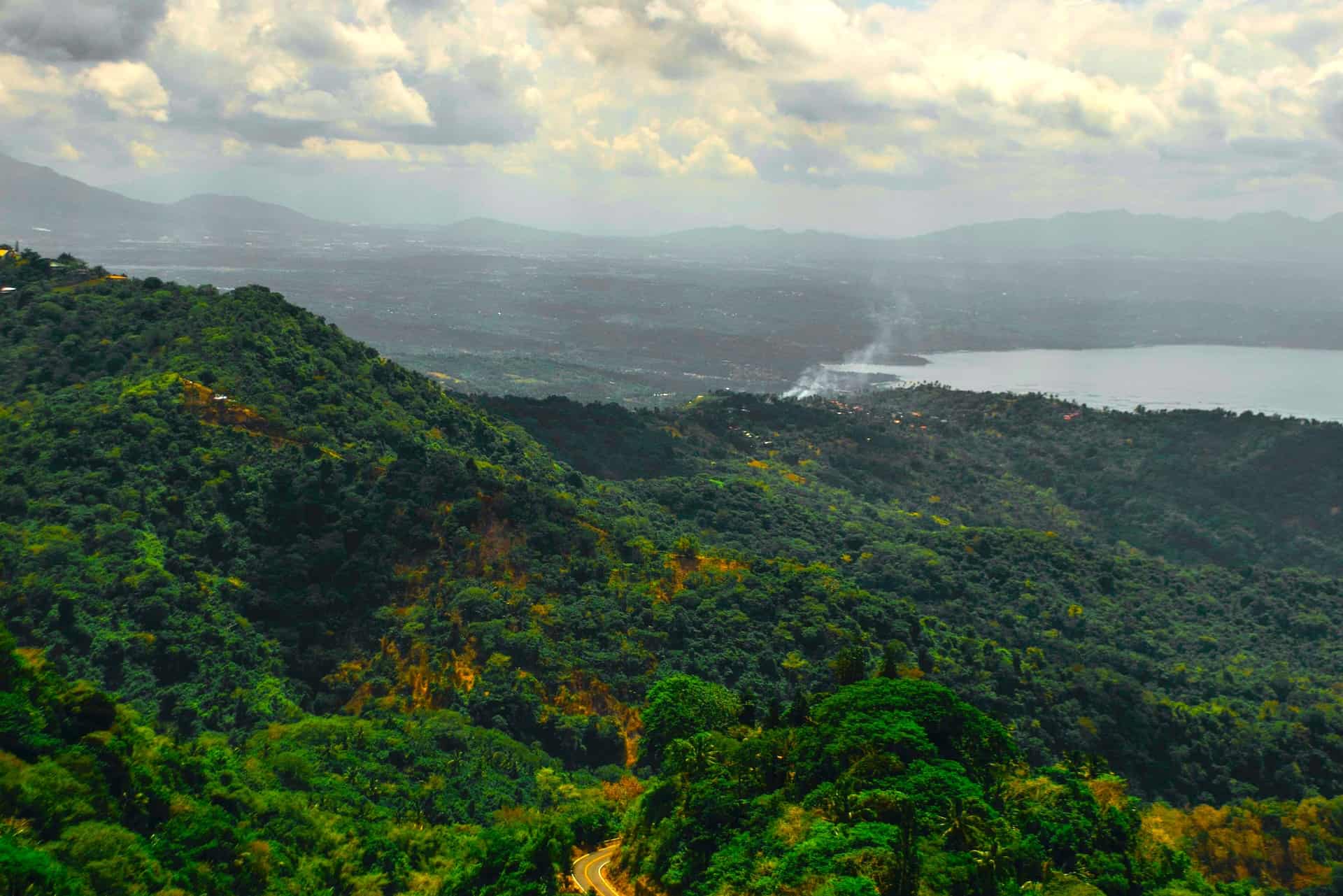
3. Historical Context of Mindanao: A Mosaic of Cultures and Eras
Mindanao, an island replete with a multifaceted history, stands as a testament to the Philippines' rich cultural and historical heritage. The island's past is a mosaic of indigenous traditions, Islamic influences, colonial encounters, and modern-day struggles, each layer adding depth to the narrative of Mindanao. This section delves into the historical context of Mindanao, exploring how the island's past has shaped its present and continues to influence its future.
The Early History and Indigenous Peoples of Mindanao
The history of Mindanao is deeply rooted in the traditions and cultures of its indigenous peoples. Long before the arrival of foreign influences, various ethnic groups such as the Lumad and the Moro inhabited the Mindanao Island Group. These groups, with their distinct languages, customs, and beliefs, laid the foundational cultural fabric of Mindanao. Their connection to the land and their ancestral domains has been a vital part of Mindanao's history, informing the island's cultural identity and heritage.
The Advent of Islam and the Sultanates
A significant turning point in Mindanao's history was the arrival of Islam. Islam reached the shores of Mindanao through traders and missionaries from neighboring regions, profoundly impacting the island's cultural and political landscape. The establishment of Sultanates, particularly in the southwestern part of Mindanao and the Sulu Archipelago, marked the beginning of a new era. These Sultanates, with their distinct governance systems and Islamic traditions, became influential centers of power and culture in Mindanao, contributing to the island's diversity.
Colonial Encounters and Resistance
Mindanao's history was further shaped by its encounters with colonial powers. The Spanish, who colonized much of the Philippines, made several attempts to conquer Mindanao. However, they faced fierce resistance from the indigenous and Muslim populations, who valiantly defended their land and culture. This resistance against Spanish colonization was a defining feature of Mindanao's history, showcasing the resilience and determination of its people.
The American period brought new challenges and changes to Mindanao. The introduction of Christian settlers from other parts of the Philippines, facilitated by the American colonial government, led to significant demographic shifts in Mindanao. This migration, while contributing to the island's diversity, also sowed the seeds for future conflicts and land disputes.
Mindanao in the Modern Era
In the modern era, Mindanao has continued to play a crucial role in the Philippines' narrative. The island has been a hotspot for various political and social movements, reflecting the ongoing struggles for autonomy, recognition, and development. The establishment of the Autonomous Region in Muslim Mindanao (ARMM) was a significant milestone, acknowledging the unique identity and aspirations of Muslim Mindanao.
The history of Mindanao, however, has not been without its challenges. The island has experienced periods of conflict and unrest, particularly in areas affected by separatist movements and political instability. These conflict-affected areas in Mindanao have been the focus of peace efforts and development initiatives, aimed at addressing the root causes of unrest and fostering a more inclusive and prosperous future for Mindanao.
Mindanao's Place in National and Global History
Mindanao's historical context is not just a local narrative; it is intrinsically linked to the national and global historical developments. The island's interactions with neighboring regions, its role in the broader colonial history of the Philippines, and its participation in modern-day geopolitical dynamics have positioned Mindanao as a significant player on the national and international stage.
Mindanao's history is a story of convergence and divergence, where various cultures, religions, and political forces have intersected. This rich historical tapestry has shaped the identity of Mindanao, making it a unique and integral part of the Philippine archipelago.
In conclusion, the historical context of Mindanao is as diverse and complex as the island itself. From its indigenous roots to its Islamic heritage, from colonial resistance to modern-day challenges, Mindanao's history is a narrative of resilience, diversity, and transformation. As we explore further into the aspects of Mindanao's culture, economy, and society, the historical underpinnings of the island continue to provide a deeper understanding of its present and a vision for its future.
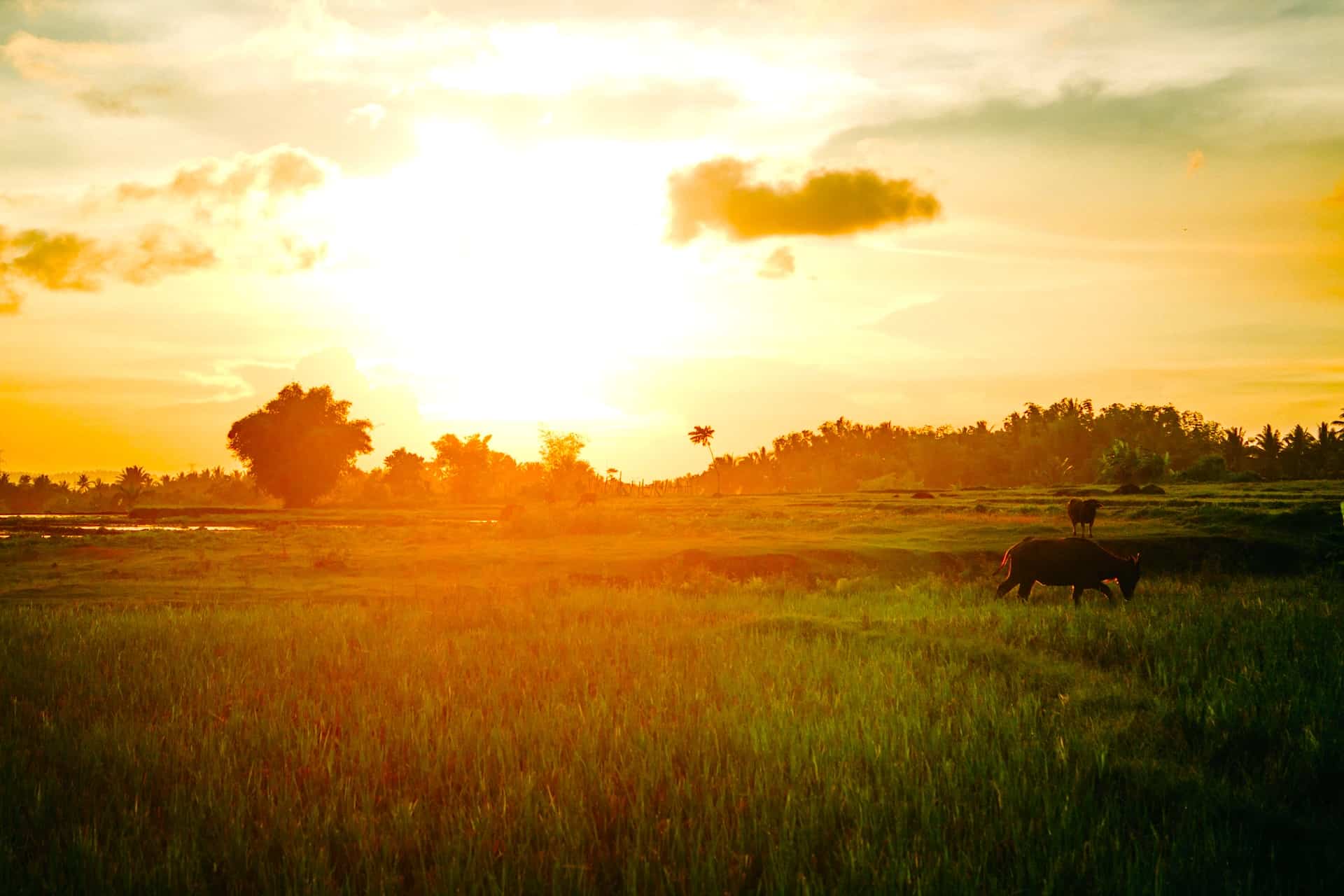
4. Demographics and Culture of Mindanao: A Diverse Mosaic
Mindanao, a crucial part of the Philippine archipelago, is a melting pot of cultures, ethnicities, and languages. This section delves into the demographic composition and cultural richness of Mindanao, highlighting the diversity that defines this island.
Ethnic Diversity and Population
Mindanao's population is a vibrant mix of various ethnic groups, each contributing its unique heritage to the island's cultural mosaic. The island is home to the Lumad, the indigenous peoples of western Mindanao alone, and the Moro, who are predominantly Muslim. The cultural diversity of Mindanao is further enriched by the presence of settlers from other parts of the Philippines, particularly from the Visayas and Luzon regions.
The Philippine Statistics Authority and the National Statistics Office have played pivotal roles in capturing the demographic nuances of Mindanao. According to their data, Mindanao's total population, is a blend of the vast majority of indigenous and settler communities, with each group bringing its own traditions, languages, and lifestyles.
Languages and the Lingua Franca
The linguistic landscape of Mindanao is as diverse as its people. While Cebuano is widely spoken across many parts of the island, other languages such as Hiligaynon, Chavacano, and Maranao are also prevalent. These languages serve not only as a means of communication but also as a reflection of Mindanao's rich cultural heritage. The diversity of languages in Mindanao underscores the island's history as a crossroads of cultures.
Cultural Practices and Traditions
Mindanao's cultural fabric is a tapestry woven from the traditions of its various ethnic groups. The island's festivals, such as the Kadayawan in Davao City and the Higalaay Festival in Cagayan de Oro, showcase the vibrant customs and lifestyles of its people. These celebrations are more than just tourist attractions; they are a living testament to Mindanao's cultural richness and diversity.
The Islamic heritage of Mindanao, particularly in the southwestern part of the island and the Sulu Archipelago, adds another layer to its cultural identity. Mosques and Islamic festivals reflect the deep-rooted influence of Islam in the cultural and social life of Mindanao.
The Role of Urban Centers in Cultural Integration
Cities like Davao City, Cagayan de Oro, and Zamboanga City are not just economic hubs but also centers of cultural integration. These cities, home to a significant portion of Mindanao's population, are where different cultures, traditions, and languages converge. They serve as melting pots where the diverse elements of Mindanao's culture blend and coexist.
Challenges and Opportunities
While Mindanao's cultural diversity is a source of strength, it also presents challenges. Ensuring harmony and understanding among its varied population requires continuous effort and sensitivity. The entire population of Mindanao, from the indigenous communities to the settlers, plays a role in fostering a culture of inclusivity and respect.
In conclusion, the demographics and culture of Mindanao paint a picture of a region rich in diversity and tradition. From its ethnic groups to its languages and cultural practices, Mindanao is a testament to the Philippines' pluralistic identity. As Mindanao continues to evolve, its cultural heritage remains a fundamental aspect of its identity, offering insights into its past and guiding its path forward.
5. Natural Landscapes of Mindanao: A Haven of Biodiversity and Beauty
Mindanao, with its diverse ecosystems and stunning natural beauty, is a testament to the Philippines' rich environmental heritage. This section explores the varied natural landscapes of Mindanao, from its towering mountains to its serene islands, highlighting the island's ecological significance.
Mountains of Mindanao: Peaks of Majesty
Mindanao is home to some of the Philippines' most majestic mountains, including Mount Apo, the country's highest peak. These mountains are not only significant for their natural beauty but also for their ecological importance. They harbor a wide range of flora and fauna, some of which are endemic to the region. The mountains of Mindanao are a crucial part of the island's ecological system, providing habitats for wildlife and acting as watersheds for the island's rivers.
The Sulu Archipelago: A Marine Paradise
The Sulu Archipelago, part of the Mindanao Island Group, is renowned for its crystal-clear waters and rich marine life. This cluster of islands in the southwestern part of Mindanao is a haven for biodiversity, with its coral reefs, mangroves, and marine sanctuaries. The archipelago is not just a natural wonder but also a vital part of the livelihood and culture of the communities that inhabit these islands.
Mindanao's Coastal and Marine Ecosystems
The coastal areas of Mindanao are as diverse as the island itself. From the tranquil beaches of the Zamboanga Peninsula to the rugged shores of Northern Mindanao, the island's coastline is a mosaic of ecosystems. These coastal regions play a significant role in the livelihoods of many communities in Mindanao, particularly in the fishing industry. They are also important for the ecological balance of the region, providing habitats for a variety of marine species.
Biodiversity and Conservation Efforts
Mindanao's natural landscapes are a hotspot for biodiversity. The island's various ecosystems support a wide array of species, some of which are unique to the region. However, these natural treasures face threats from deforestation, overfishing, and environmental degradation. Conservation efforts are underway to preserve Mindanao's natural heritage, involving local communities, government agencies, and non-governmental organizations. These efforts are crucial for maintaining the ecological balance and ensuring the sustainability of Mindanao's natural resources.
The Role of Mindanao in the Philippines' Environmental Health
The ecological significance of Mindanao extends beyond its borders. The island's forests, mountains, and marine ecosystems are integral to the environmental health of the entire Philippines. Mindanao's natural landscapes not only contribute to the country's biodiversity but also play a role in climate regulation and disaster resilience.
In conclusion, the natural landscapes of Mindanao are a vital part of the island's identity and heritage. From the peaks of its mountains to the depths of its seas, Mindanao's natural beauty is a source of pride and a responsibility for its people. Preserving these landscapes for future generations is essential for maintaining the ecological and cultural richness of Mindanao.
6. Economy and Development of Mindanao: Growth, Challenges, and Opportunities
Mindanao, often referred to as the Philippines' "Land of Promise," is a region with a complex and dynamic economy. This section explores the economic landscape of Mindanao, highlighting its growth sectors, the challenges it faces, and the opportunities for future development.
Agriculture: The Backbone of Mindanao's Economy
Agriculture is a cornerstone of Mindanao's economy. The island's fertile lands and diverse climate allow for the cultivation of a variety of crops. Mindanao is particularly known for its production of fruits like bananas and pineapples, which are significant contributors to the Philippine agricultural sector. The vast majority of Mindanao's rural population is engaged in farming, making agriculture not just an economic activity but a way of life.
Mindanao's Growing Service Sector
While agriculture remains a key part of Mindanao's economy, the service sector has shown significant growth. Cities like Davao City and Cagayan de Oro have become centers for trade, finance, and services. The growth of these urban centers has spurred development in other provinces in the region, creating jobs and opportunities for Mindanao's population.
Industrial Development and Challenges
Mindanao's industrial sector, though smaller compared to agriculture and services, plays a vital role in the island's economy. Industries such as food processing, mining, and manufacturing contribute to Mindanao's economic output. However, industrial development in Mindanao faces challenges, including infrastructure gaps and the need for sustainable practices to protect the island's natural resources.
Tourism: A Growing Contributor to Mindanao's Economy
Tourism in Mindanao has been a growing sector, with the island's natural landscapes, rich culture, and historical sites attracting visitors from around the world. Destinations like the Sulu Archipelago and the mountains of Mindanao offer unique experiences for tourists. However, developing tourism sustainably and inclusively remains a challenge, requiring careful planning and community involvement.
The Role of Major Cities in Economic Development
Major cities in Mindanao, such as Davao City and Zamboanga City, are not only cultural hubs but also key drivers of economic growth. These cities serve as gateways for trade and investment, playing a crucial role in Mindanao's economic development. The growth of these urban centers is pivotal for the overall development of the island.
Addressing Economic Disparities and Conflict-Affected Areas
Despite its potential, Mindanao faces economic disparities, particularly in conflict-affected areas. Efforts to promote inclusive development and address the root causes of conflict are essential for the island's long-term economic stability and growth. Initiatives to boost economic activities in these areas are crucial for Mindanao's overall development.
Mindanao's Future Economic Prospects
Mindanao's economic future holds promise, with opportunities for growth in sectors like agriculture, services, tourism, and technology. The key to harnessing these opportunities lies in addressing current challenges, promoting sustainable practices, and fostering inclusive development that benefits the entire population of Mindanao.
In conclusion, Mindanao's economy is a complex interplay of traditional sectors and modern growth areas. The island's economic development is crucial not just for its population but for the Philippines as a whole. As Mindanao continues to evolve, balancing growth with sustainability and inclusivity will be key to realizing its full potential.
7. Socio-Political Landscape of Mindanao: Navigating Challenges and Seeking Peace
Mindanao's socio-political landscape is as diverse and complex as its cultural and geographic makeup. In this section, we explore the various socio-political dimensions of Mindanao, including its history of conflict, efforts towards peace, and the ongoing challenges in building a harmonious and progressive society.
History of Conflict and Efforts for Peace
Mindanao has been a focal point of conflict in the Philippines, particularly in areas with significant Muslim populations. The root causes of these conflicts are multifaceted, including issues of autonomy, land rights, and religious and cultural identity. In response, various peace initiatives have been undertaken over the years, aimed at addressing the underlying issues and fostering a sustainable peace process.
The establishment of the Autonomous Region in Muslim Mindanao (ARMM) was a significant step towards recognizing the unique cultural and political identity of Muslim Mindanao. This autonomous region, although imperfect, represented an attempt to provide a degree of self-governance and address some of the grievances of the Muslim population in Mindanao.
The Role of National and International Organizations
The peace process in Mindanao has involved a range of stakeholders, including national government agencies, local governments, civil society groups, and international organizations. The Philippine Statistics Authority and the National Statistics Office have provided crucial data to inform policy decisions in conflict-affected areas. International bodies have also played a role in mediating and supporting peace initiatives in Mindanao.
Development Challenges in Conflict-Affected Areas
Conflict-affected areas in Mindanao face unique development challenges. These areas often lag behind in terms of infrastructure, education, health services, and economic opportunities. Addressing these disparities is crucial for achieving lasting peace and stability in Mindanao. Efforts to promote development in these areas are not just about economic growth but also about building social cohesion and resilience.
The Evolving Political Landscape
Mindanao's political landscape is continually evolving. Local governance in Mindanao, particularly in major cities like Davao City and Zamboanga City, plays a critical role in addressing the region's challenges. The decentralization of political power and the empowerment of local governments are seen as key factors in addressing the unique needs of Mindanao's diverse population.
The Future of Socio-Political Stability in Mindanao
Looking ahead, the socio-political stability of Mindanao hinges on the successful integration of its diverse population, the equitable distribution of resources, and the effective management of its political affairs. The journey towards peace and stability in Mindanao is ongoing, requiring the concerted efforts of all sectors of society.
In conclusion, the socio-political landscape of Mindanao reflects the island's complex history and diverse society. Navigating the challenges in this landscape requires a nuanced understanding of Mindanao's cultural, religious, and political dynamics. As Mindanao continues to strive for peace and development, the collective efforts of its people and supportive policies will be crucial in shaping its future.
8. Mindanao in the National Context: Integrating Diversity into the Philippine Tapestry
Mindanao, as a crucial component of the Philippines, offers a unique perspective on the country’s cultural, political, and economic landscape. This section examines Mindanao's role and significance within the broader context of the Philippines, highlighting its contributions and the challenges it faces in integrating into the national narrative.
Mindanao's Contribution to Philippine Diversity
Mindanao's diverse cultural heritage is a significant contributor to the Philippines' identity as a nation. The array of ethnic groups, languages, and traditions found in Mindanao enriches the Philippine cultural mosaic. From the indigenous Lumad communities to the Muslim populations in the Sulu Archipelago and other parts of Mindanao, each group adds a unique thread to the national fabric.
Economic Contributions and Challenges
Economically, Mindanao plays a pivotal role in the Philippines. Its agricultural output, particularly in crops like bananas and pineapples, is vital to the country's food security and export economy. Mindanao's growing service sector, centered around cities like Davao City and Cagayan de Oro, contributes significantly to the national economy. However, addressing the economic disparities and developing the conflict-affected areas remain critical challenges for integrating Mindanao's economy with the national economy.
Political Representation and Autonomy
Politically, Mindanao has been striving for greater representation and autonomy within the Philippine governance structure. The establishment and subsequent evolution of the Autonomous Region in Muslim Mindanao (ARMM) have been significant steps in acknowledging the unique political and cultural context of Mindanao. The country' ongoing peace process and efforts to provide greater autonomy and governance rights to Mindanao are crucial in integrating the region into the country' national political landscape.
Mindanao's Role in National Development
Mindanao's development is not just a regional concern but a national priority. The island's progress has implications for the Philippines' overall growth and stability. National policies and development initiatives need to consider Mindanao's unique context to ensure inclusive and sustainable development across the country.
The Road Ahead: Integrating Mindanao's Narrative
Integrating Mindanao's narrative into the national story requires understanding and appreciating the island's diversity, addressing its challenges, and leveraging its potential. The future of the Philippines as a cohesive and prosperous nation is linked to how well Mindanao's diversity is integrated into the national tapestry.
In conclusion, Mindanao's role in the Philippine context is multifaceted and integral. Its cultural diversity, economic potential, and political dynamics are essential components of the Philippines' national identity. The journey towards fully integrating Mindanao into the Philippine narrative is ongoing, requiring collaborative efforts from both the Mindanaoan people and the broader national community.
9. Current Challenges and Future Perspectives in Mindanao: Charting a Path Forward
Mindanao, while rich in resources and cultural diversity, faces a range of challenges that impact its development and the well-being of its people. This section examines the current challenges confronting Mindanao and explores the potential pathways for its future development.
Addressing Economic and Social Disparities
One of the most pressing challenges in Mindanao is the economic and social disparities between different regions and communities. While some areas, particularly major cities like Davao City and Cagayan de Oro, have experienced significant development, other parts, especially conflict-affected areas, lag behind in terms of infrastructure, education, healthcare, and economic opportunities. Bridging these gaps is crucial for the overall development and stability of Mindanao.
The Impact of Conflict on Development
The long-standing conflict in certain areas of Mindanao has hindered development and exacerbated poverty and displacement. Addressing the root causes of these conflicts, which often stem from issues related to land, identity, and political representation, is essential for achieving lasting peace and development. Efforts towards peace and reconciliation, involving all stakeholders, are vital for the future of Mindanao.
Environmental Sustainability
Mindanao's natural environment, including its forests, mountains, and marine ecosystems, faces threats from deforestation, pollution, and overfishing. Ensuring environmental sustainability is a major challenge, requiring concerted efforts to promote responsible resource management and environmental protection. The future of Mindanao's development is closely tied to the health of its natural ecosystems.
Enhancing Education and Healthcare
Improving the quality of education and healthcare in Mindanao is fundamental to its development. Access to quality education and healthcare services is uneven across the island, with rural and conflict-affected areas particularly disadvantaged. Investing in these sectors is essential for building a healthy, educated, and skilled population that can contribute to Mindanao's growth and development.
Future Perspectives: Opportunities and Potential
Looking ahead, Mindanao holds significant potential for development across various sectors. The agricultural sector, a mainstay of Mindanao's economy, has room for growth and modernization. The expansion of the service and industrial sectors, coupled with sustainable tourism, presents opportunities for economic diversification. Additionally, the rich cultural heritage and natural beauty of Mindanao offer immense potential for cultural and eco-tourism.
Building an Inclusive and Prosperous Mindanao
The future of Mindanao hinges on building an inclusive society that addresses the needs and aspirations of its entire population. Efforts to promote economic growth, social equity, and environmental sustainability are key to ensuring a prosperous future for Mindanao. This requires collaboration among government agencies, local communities, private sector, and international partners.
In conclusion, while Mindanao faces significant challenges, its future is full of possibilities. Addressing current issues and leveraging the island's diverse resources and cultural heritage are crucial for charting a positive path forward. The journey towards a prosperous and peaceful Mindanao is a collective endeavor, requiring commitment and action from all stakeholders.
10. Conclusion: Embracing Mindanao's Diversity and Potential
As we conclude our exploration of Mindanao, it becomes clear that this island is not just a geographical entity in the southern Philippines but a vibrant, dynamic region with a rich tapestry of cultures, histories, and potential. This section reflects on the essence of Mindanao, its role in shaping the future of the Philippines, and the path forward for this diverse and resource-rich region.
Mindanao: A Land of Diversity and Resilience
Mindanao's diversity is its greatest strength. The island is home to a myriad of ethnic groups, languages, and cultures, each contributing to the vibrant mosaic that is Mindanao. From the indigenous Lumad communities to the Muslim populations in the Sulu Archipelago and other parts of the island, Mindanao showcases the Philippines' cultural and ethnic richness.
Economic and Environmental Stewardship
The economy of Mindanao, with its focus on agriculture, industry, and services, holds significant potential for the future. Cities like Davao City and Cagayan de Oro are emerging as economic hubs, driving growth and development. However, this growth must be balanced with environmental stewardship. Preserving Mindanao's natural landscapes, from its highest mountain peaks to its marine ecosystems, is essential for sustainable development.
Overcoming Challenges and Building a Peaceful Future
Mindanao faces its share of challenges, from economic disparities to the impact of long-standing conflicts. Addressing these issues requires a concerted effort from all stakeholders, including the government, local communities, and international partners. Building a peaceful and prosperous Mindanao is a journey that involves fostering understanding, addressing grievances, and investing in the region's development.
Mindanao's Role in the Philippines and Beyond
Mindanao is not only integral to the Philippines but also plays a significant role in the broader Southeast Asian region. Its strategic location, cultural diversity, and natural resources position it as a key player in regional dynamics. The future of Mindanao will undoubtedly influence the socio-economic landscape of the Philippines and its neighbors.
A Vision for Mindanao: Inclusivity, Prosperity, and Sustainability
The vision for Mindanao is one of inclusivity, prosperity, and sustainability. Embracing the region's diversity, harnessing its economic potential, and protecting its natural environment are critical for this vision to become a reality. The future of Mindanao lies in the hands of its people, whose resilience, creativity, and spirit will drive the region forward.
In conclusion, Mindanao stands as a testament to the Philippines' diverse heritage and potential. It is a region rich in resources, culture, and possibilities. As Mindanao continues to evolve, it remains a vital part of the Philippine archipelago, contributing to the nation's narrative and shaping its future.
11. Mindanao's Place in Global Dynamics: Looking Beyond the Horizon
In this section, we explore Mindanao's interactions with global dynamics, examining how this diverse and complex island integrates with and influences the broader international community.
Mindanao's Economic Contributions to Global Markets
Mindanao, as a key agricultural and industrial player in the Philippines, contributes significantly to global markets. Its export of tropical fruits, such as bananas and pineapples, places Mindanao on the international trade map. Additionally, the island's growing industrial sector, including mining and manufacturing, has potential for further integration into global supply chains.
Cultural Exchange and Global Influence
The rich cultural tapestry of Mindanao, with its diverse ethnic groups and traditions, offers a unique cultural exchange opportunity on a global stage. Festivals, arts, and crafts from regions such as Davao City and the Sulu Archipelago attract international interest, showcasing Mindanao's heritage. These cultural exchanges not only promote understanding but also enhance Mindanao's global influence.
Environmental Conservation and Global Initiatives
Mindanao's natural landscapes, from its highest mountains to its marine ecosystems, have significant environmental importance. Conservation efforts in Mindanao contribute to global biodiversity and environmental sustainability initiatives. These efforts highlight the role of local actions in contributing to global environmental health.
Mindanao in International Diplomacy and Peace Efforts
Mindanao's journey towards peace and stability has implications for international diplomacy. The island's experience in resolving conflicts and fostering peace offers valuable insights for global peace initiatives. The international community's role in supporting peace processes in Mindanao underscores the importance of collaborative efforts in achieving lasting peace.
Mindanao and Overseas Connections
The diaspora from Mindanao, residing in various parts of the world, establishes a global network that links Mindanao to international communities. These overseas connections facilitate cultural, economic, and social exchanges, further integrating Mindanao into the global landscape.
Challenges and Opportunities on the Global Stage
Mindanao faces challenges in its global interactions, including navigating international trade dynamics and addressing global environmental concerns. However, these challenges also present opportunities for Mindanao to assert its role in international affairs and contribute to global discussions on development, sustainability, and cultural exchange.
In conclusion, Mindanao's place in global dynamics is marked by its economic contributions, cultural richness, environmental significance, and peace-building efforts. The island's integration with the global community highlights the importance of local actions in shaping international relations. As Mindanao continues to grow and evolve, its interactions with the global stage will play a crucial role in defining its future and that of the broader international community.
12. Preserving Mindanao's Cultural Heritage and Environment: A Path to Sustainable Future
In this section, we delve into the efforts to preserve the rich cultural heritage and natural environment of Mindanao, highlighting the importance of these initiatives for the island's sustainable future.
Safeguarding Cultural Heritage
Mindanao's diverse cultural heritage, reflected in its various ethnic groups and traditions, is a vital part of its identity. Preserving this heritage, from the traditional dances of the Lumad people to the Islamic arts in the Sulu Archipelago, is crucial. Cities like Davao City and Zamboanga City play a key role in these preservation efforts, hosting cultural festivals and supporting museums and arts programs.
Environmental Protection and Conservation
The natural environment of Mindanao, including its highest mountains, forests, and marine ecosystems, is under threat from deforestation, pollution, and climate change. Initiatives to protect these natural landscapes are essential for the island's ecological balance and the well-being of its inhabitants. Efforts like reforestation programs, wildlife protection initiatives, and sustainable tourism practices contribute to the conservation of Mindanao's environment.
Community Involvement in Preservation Efforts
The involvement of local communities is crucial in the preservation of both cultural heritage and the environment. Community-led initiatives that embrace traditional knowledge and practices are often more sustainable and effective. Empowering communities in Mindanao to take an active role in preservation efforts ensures that these initiatives are rooted in the local context and have a lasting impact.
Challenges in Preservation
Preserving the cultural and environmental heritage of Mindanao is not without challenges. Balancing development needs with conservation, addressing funding and resource limitations, and ensuring community participation are key issues that need to be addressed. The conflict-affected areas of Mindanao also face unique challenges in preservation efforts, requiring tailored approaches and sensitive interventions.
The Role of Government and International Partnerships
The government, both at the national and local levels, plays a significant role in the preservation of Mindanao's cultural and environmental heritage. Policies, funding, and support for preservation initiatives are crucial. International partnerships also offer valuable resources and expertise, aiding in the country and municipalities' preservation efforts and bringing global attention to Mindanao's cultural and environmental treasures.
Looking Ahead: A Sustainable and Resilient Mindanao
The future of Mindanao hinges on the successful preservation of its cultural and environmental heritage. These efforts are not just about maintaining the past but about building a sustainable and resilient future for Mindanao. Integrating preservation with development, engaging communities, and fostering a sense of stewardship among the people of Mindanao are key to ensuring the island's cultural and environmental legacy endures for generations to come.
In conclusion, the preservation of Mindanao's cultural heritage and natural environment is a vital component of its sustainable development. These efforts reflect the island's rich history, diverse cultures, and ecological importance, contributing to a resilient and vibrant future for Mindanao.
Sources: https://en.wikipedia.org/wiki/Mindanao

